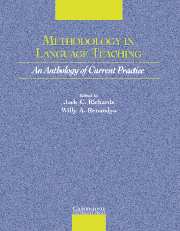Book contents
- Frontmatter
- Contents
- Acknowledgments
- Introduction
- Section I Approaches to Teaching
- Section 2 Lesson Planning and Classroom Management
- Section 3 Classroom Dynamics
- Chapter 5 Implementing Cooperative Learning
- Chapter 6 Mixed-Level Teaching: Tiered Tasks and Bias Tasks
- Section 4 Syllabus Design and Instructional Materials
- Section 5 Task and Project Work
- Section 6 Learning Strategies
- Section 7 Teaching Grammar
- Section 8 Teaching Pronunciation
- Section 9 Teaching Speaking
- Section 10 Teaching Listening
- Section 11 Teaching Vocabulary
- Section 12 Teaching Reading
- Section 13 Teaching Writing
- Section 14 Assessment
- Section 15 Technologies in the Classroom
- Section 16 Professional Development
- Credits
- Author Index
- Subject Index
Chapter 6 - Mixed-Level Teaching: Tiered Tasks and Bias Tasks
Published online by Cambridge University Press: 10 November 2010
- Frontmatter
- Contents
- Acknowledgments
- Introduction
- Section I Approaches to Teaching
- Section 2 Lesson Planning and Classroom Management
- Section 3 Classroom Dynamics
- Chapter 5 Implementing Cooperative Learning
- Chapter 6 Mixed-Level Teaching: Tiered Tasks and Bias Tasks
- Section 4 Syllabus Design and Instructional Materials
- Section 5 Task and Project Work
- Section 6 Learning Strategies
- Section 7 Teaching Grammar
- Section 8 Teaching Pronunciation
- Section 9 Teaching Speaking
- Section 10 Teaching Listening
- Section 11 Teaching Vocabulary
- Section 12 Teaching Reading
- Section 13 Teaching Writing
- Section 14 Assessment
- Section 15 Technologies in the Classroom
- Section 16 Professional Development
- Credits
- Author Index
- Subject Index
Summary
No one wants to use three different course books with one class: one for strong students, one for weak students, and one for midlevel students. But when faced with mixed-level classes and an unhelpful course book, what do you do? How exactly can you adapt reading and listening activities to suit stronger and weaker students?
This article aims to provide clear guidelines for teachers who, from time to time, want to make their course book reading and listening materials more flexible.
COMMUNICATIVE TEACHING PRINCIPLES
Two communicative teaching principles underline the multilevel techniques we are going to outline:
We do not believe that it is necessary for students to understand or translate every word of a reading or a listening text. If students complete the task we set – answering a certain number of questions, marking a given number of sentences true or false – we feel that they have read or listened successfully.
We believe that students' ability to read or listen successfully is governed by a simple equation: text level of challenge + task level of support= student success.
With a long, complex text, a simple task makes the reading or listening achievable for weaker students. With a shorter, simpler text, the task can be more demanding. Bearing these principles in mind, we have isolated two ways of adapting reading or listening activities for mixed-level classes. We call them tiered tasks and bias tasks.
- Type
- Chapter
- Information
- Methodology in Language TeachingAn Anthology of Current Practice, pp. 59 - 64Publisher: Cambridge University PressPrint publication year: 2002
- 3
- Cited by



